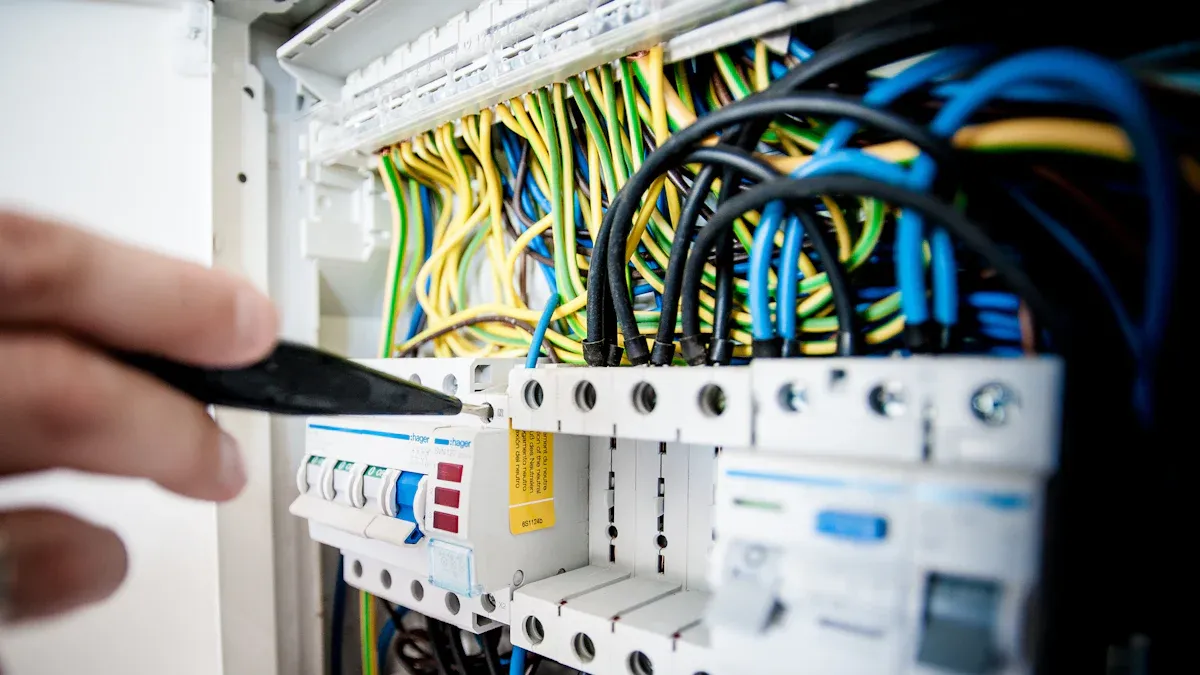
Modern facilities are rapidly transforming power management with the integration of Smart PDUs. These advanced devices provide predictive maintenance, dynamic power distribution, and energy optimization.
| Statistic / Feature | Details |
|---|---|
| Market CAGR | 6.85% growth for data center PDUs and PSUs |
| Space Savings | Up to 36% with new designs |
Key Takeaways
- Smart PDUs provide real-time monitoring and remote control of power outlets, helping facilities optimize energy use and reduce downtime.
- These devices improve energy efficiency by up to 20%, cut power waste by up to 30%, and support scalable, flexible power management for growing IT environments.
- Integration with management systems and advanced analytics enables proactive maintenance, cost savings, and supports sustainability goals by lowering carbon footprints.
Smart PDU: Defining the Technology
What Is a Smart PDU?
A Smart PDU is an advanced power distribution unit that goes beyond simple power delivery. It provides real-time data on power usage and allows remote control of outlets. These devices combine the features of switched and metered PDUs, offering detailed power metrics at each outlet, remote switching, and proactive notifications. Smart PDUs integrate with Data Center Infrastructure Management (DCIM) systems, making them ideal for large data centers and energy-focused operations. Their design supports secure network protocols and user authentication, ensuring both reliability and security.
Key Differences Between Smart and Basic PDUs
Smart PDUs stand out from basic PDUs through their advanced monitoring and management features. Basic PDUs deliver power reliably but do not offer monitoring or remote management. In contrast, Smart PDUs enable real-time monitoring, remote outlet control, and energy optimization. The table below highlights these differences:
| Feature | Basic PDU | Smart PDU |
|---|---|---|
| Monitoring | None | Real-time power usage monitoring |
| Remote Management | Not available | Remote control of individual outlets |
| Energy Efficiency | Basic power distribution | Optimizes energy consumption |
| Scalability | Limited to small setups | Adapts to dynamic IT environments |
| Cost Considerations | More affordable | Higher cost due to advanced features |
Smart PDUs can reduce energy consumption by up to 20% and help organizations save significant operational costs.
Essential Role of Smart PDUs in Today’s Power Management
Smart PDUs play a vital role in modern power management. They improve energy efficiency by up to 20% and reduce energy waste by 20-30%. Remote monitoring and load balancing lower downtime risks by 15-25%. Environmental sensors on these units can cut cooling costs by 10-15%. Integration with DCIM software enhances Power Usage Effectiveness (PUE) by up to 20%. Maintenance teams respond 40% faster to issues with remote monitoring features. The chart below shows the quantifiable benefits of using Smart PDUs:
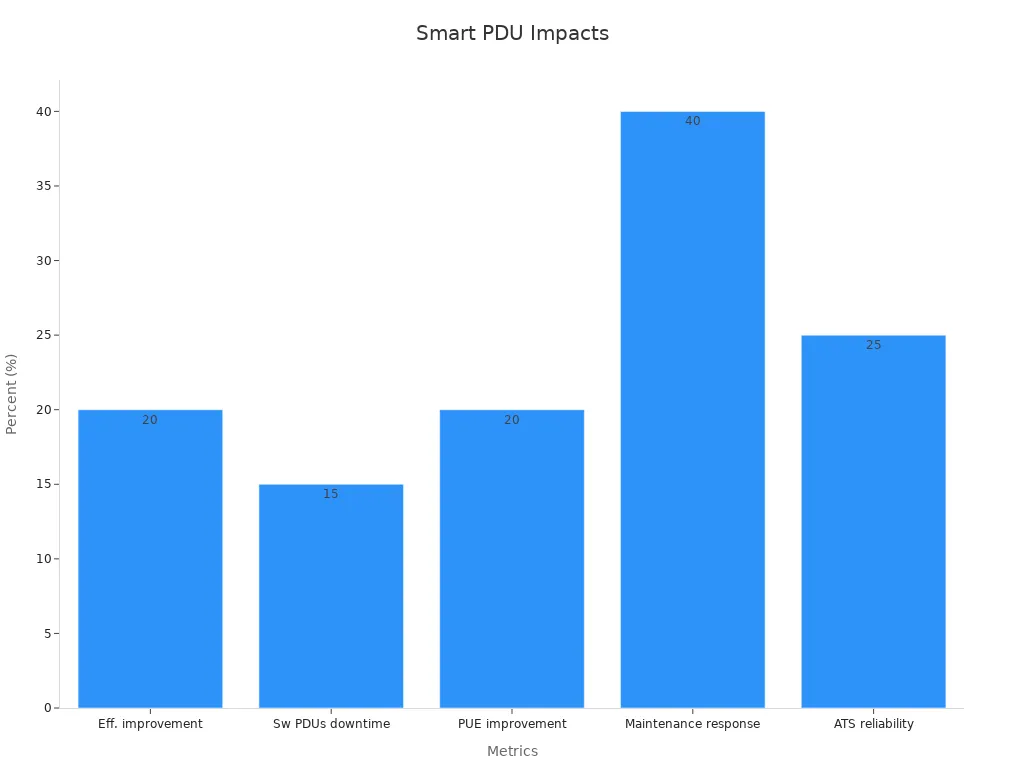
Smart PDUs have become essential for facilities seeking higher efficiency, reliability, and cost savings.
Evolution from Traditional to Smart PDU Solutions
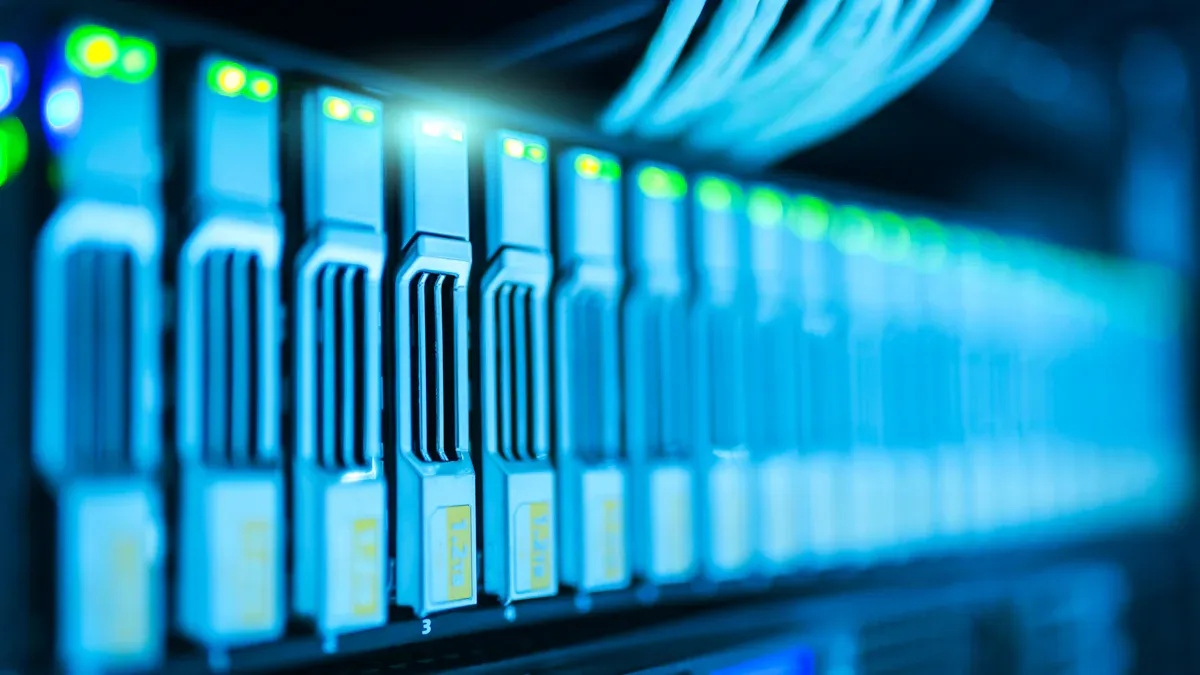
Limitations of Legacy Power Distribution Units
Legacy power distribution units served as the backbone of early data centers and industrial environments. These units provided basic power delivery but lacked advanced monitoring and control features. Operators could not track energy consumption in real time or manage outlets remotely. This limitation often led to inefficient energy use and increased operational costs. Maintenance teams faced challenges in identifying faults quickly, which sometimes resulted in longer downtimes. As data centers grew, the need for scalable and flexible power solutions became more urgent.
The following table highlights key metrics that illustrate the transition from traditional to modern solutions:
| Metric/Aspect | Data/Trend Description |
|---|---|
| Global Market Size (2025) | Over 20 million units |
| Projected Annual Growth Rate | Exceeding 5% annually through 2033, reaching over 30 million units |
| Market Value (2025) | $630 million |
| Key Drivers | Data center adoption, industrial automation, energy efficiency regulations |
| Industry Trends | Shift from traditional to smart PDUs driven by efficiency, monitoring, and operational improvements |
Advancements Driving the Shift to Smart PDU
Several advancements have fueled the move toward intelligent power management. Integration of AI and IoT now enables real-time monitoring and predictive maintenance. Automation in data centers optimizes load balancing and power distribution. Modular and scalable designs support flexible infrastructure growth. Enhanced power management software improves energy control and reliability. The market for PDUs is projected to grow from $4.2 billion in 2024 to $8.9 billion by 2034, with intelligent units holding a dominant share.
- AI and machine learning enhance predictive maintenance and energy efficiency.
- Sustainability drives adoption of energy-saving and eco-friendly PDUs.
- Remote monitoring and cloud-based solutions expand operational capabilities.
- Technological improvements increase product reliability and performance.
- Demand for scalable and customizable PDUs rises in sectors like healthcare, IT, and telecommunications.
These advancements help organizations meet stricter energy regulations and support the integration of renewable energy sources.
Core Features of Smart PDU Technology
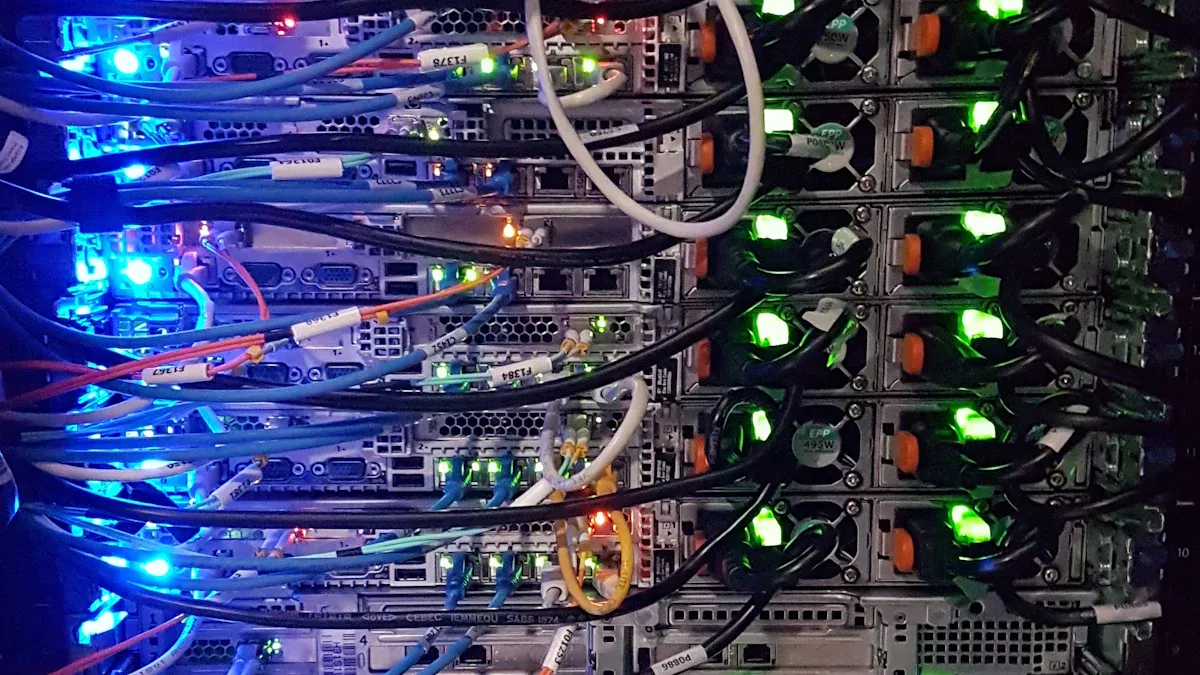
Remote Monitoring and Control Capabilities
Smart PDUs deliver advanced remote monitoring and control features that transform power management in modern facilities. Operators can access real-time data and manage power distribution from anywhere using secure network or serial connections. These devices support outlet-level switching, sequential power-up, and power recycling, which help prevent overloads and enable efficient troubleshooting. User-defined alarms and threshold-based alerts notify teams of abnormal power consumption, reducing the risk of downtime.
The following table highlights key performance metrics that validate these capabilities:
| Metric/Feature | Description |
|---|---|
| PDU Level Metering | RMS volts, current, and power metering at the PDU level |
| Outlet Level Metering | Power metering at individual outlets |
| User-Defined Alarms | Threshold-based alerts for power consumption |
| Remote Access | Serial or network port access for remote monitoring |
| Outlet Control | Controlled on/off switching, power recycling, sequential power-up |
| Security | Passwords, authentication, authorization, encryption |
| Environmental Monitoring | Inlet temperature monitoring at rack locations |
| Standards Support | SNMP, IPMI, LDAP, Active Directory, RADIUS, NFS integration |
These features allow precise monitoring and control of energy consumption, support IP aggregation to reduce deployment costs, and enable user-defined alert notifications. Operators can remotely power on or off individual outlets, manage sequential power-up, and receive real-time environmental data. Standards-based management ensures compatibility with existing IT infrastructure.
Environmental Sensing and Data Collection
Environmental sensing and data collection play a crucial role in the effectiveness of Smart PDUs. These devices integrate temperature, humidity, and leak detection sensors, providing real-time data that helps prevent costly downtime. Intelligent cooling and power management optimize energy use, reducing waste and operational costs. Remote monitoring identifies underutilized resources, allowing operators to power down idle servers and achieve further energy savings.
Real-time environmental sensing helps prevent equipment damage and supports predictive maintenance, which reduces repair costs and downtime.
A few quantifiable results demonstrate the impact of these features:
- Real-time power monitoring at the outlet level enables identification of inefficient equipment, reducing energy consumption by up to 20%.
- IBM achieved a 30% energy savings in its data centers through real-time monitoring.
- The U.S. General Services Administration reduced energy use by 41%, saving $13.5 million annually.
- eBay cut operating costs by 50% at new data centers by leveraging detailed energy consumption data.
- Smart PDUs improve Power Usage Effectiveness (PUE) by providing granular power usage data.
These capabilities also contribute to sustainability goals by lowering carbon footprints and extending equipment lifespan.
Integration with Power Management Systems
Integration with power management systems enhances the operational efficiency of Smart PDUs. Real-time monitoring and load balancing reduce downtime by up to 20%. Remote management capabilities improve maintenance response times by 40%. Environmental sensor integration optimizes temperature and humidity control, leading to a 10-15% reduction in cooling costs.
- Real-time power usage tracking at both unit and outlet levels enables identification and correction of inefficiencies.
- Load balancing prevents power overloads and optimizes energy distribution, reducing outages.
- Remote monitoring and control reduce the need for physical inspections, saving energy and improving maintenance speed.
- Modular and scalable PDU designs support data center growth without operational disruption.
These improvements lead to increased energy efficiency, cost savings, and improved reliability. Integration with environmental sensors and management software ensures proactive cooling management and prevents equipment failure.
Advanced Analytics and Reporting Functions
Advanced analytics and reporting functions set Smart PDUs apart from traditional solutions. Intelligent PDUs provide real-time monitoring and detailed analytics at the outlet level. IoT integration enables remote management and predictive maintenance. Business intelligence dashboards and visual analytics convert statistical data into actionable insights, supporting proactive power management and early detection of power issues.
- Intelligent PDUs offer metering, remote power control, environmental sensors, and firmware updates.
- They support SNMP trap notifications and security improvements, enhancing operational reliability.
- Data from PDUs is transformed into actionable insights using business intelligence dashboards and visual analytics.
- Switched PDUs allow remote management of individual or grouped outlets, including power cycling and rebooting.
- Cloud-based monitoring combined with machine learning and AI enables predictive maintenance and optimization.
These features collectively reduce downtime, optimize energy consumption, and allow remote control in complex data center environments. Continuous monitoring helps organizations meet environmental regulations and manage increasing power demands.
Benefits of Smart PDU in Intelligent Power Management
Boosting Energy Efficiency and Reducing Waste
Smart PDUs play a crucial role in improving energy efficiency and minimizing waste across modern facilities. These devices use real-time monitoring, load balancing, and remote management to optimize power usage. Operators can track voltage, current, and power at each outlet, which helps identify inefficient devices and prevent overloads.
- Metered PDUs can increase energy efficiency by about 20%.
- Intelligent PDUs contribute an additional 20% reduction in energy consumption.
- Power waste can be cut by up to 30% with smart PDUs.
- Real-time monitoring and load balancing ensure even distribution of electricity, preventing device overburden.
- Remote management allows centralized control, reducing unnecessary energy use and extending equipment lifespan.
Choice Hotels International serves as a strong example. The company implemented customized PDU solutions that improved system efficiency and control. These improvements led to lower energy costs, longer equipment life, and better operational reliability. Smart PDUs support data centers, industrial facilities, and commercial buildings by managing high-density loads and reducing overheating.
Enhancing Reliability and Uptime
Reliability and uptime are essential for any power management system. Smart PDUs deliver these benefits through advanced monitoring and control features. Real-time power load monitoring helps prevent overloads and reduces downtime. Early detection of anomalies allows teams to address issues before they escalate.
- Redundancy features ensure uninterrupted power supply during outages.
- Remote monitoring and control enable faster responses to power issues.
- Expert tests show stable power distribution under fluctuating loads.
- Advanced power management balances loads and reduces energy waste, minimizing downtime.
- Robust designs withstand temperature changes and electrical surges, ensuring durability.
- User feedback highlights fewer disruptions and improved uptime due to surge protection and power stability.
Operators can monitor current, voltage, wattage, and frequency to detect irregularities. Alerts for threshold breaches enable proactive issue resolution. Integration with DCIM systems provides centralized visibility, improving operational efficiency.
Supporting Scalability and Flexible Deployment
Modern facilities require scalable and flexible power solutions. Smart PDUs offer modular designs that support easy expansion as needs grow. Operators can add or reconfigure units without disrupting operations. This flexibility supports dynamic IT environments, such as data centers and edge computing sites.
- Modular PDUs allow seamless integration into existing infrastructure.
- Flexible outlet configurations support a wide range of equipment.
- Remote management enables quick adjustments to power distribution.
- Centralized control simplifies deployment across multiple locations.
These features help organizations adapt to changing demands and support future growth without major investments or downtime.
Enabling Sustainability and Green Initiatives
Sustainability has become a top priority for many organizations. Smart PDUs help reduce carbon footprints and promote energy conservation through precise monitoring and control. Operators can detect idle servers, respond to power surges, and manage abnormal temperature changes in real time.
- Real-time monitoring and optimization of power usage at the rack level.
- Data-driven decisions for server decommissioning free up rack space and reduce unnecessary energy use.
- Granular visibility into power quality metrics helps prevent equipment damage and energy waste.
- Advanced PDUs offer high accuracy and detailed power quality data at the outlet level.
- Power Usage Effectiveness (PUE) benchmarks energy efficiency and identifies inefficiencies.
- Integration with DCIM software automates PUE calculation and provides comprehensive energy insights.
Continuous analysis of PUE supports long-term sustainability goals by improving resource utilization and reducing environmental impact.
Real-World Applications and Case Studies
Smart PDUs have proven their value in a variety of real-world scenarios. Data centers use switched PDUs for outlet-level monitoring and control, optimizing energy consumption and preventing disruptions. Commander, a telecom provider in Australia, uses switched PDUs to monitor energy usage and power capacity, which enhances operational efficiency.
- Disaster recovery operations benefit from remote power management, allowing prioritized power-up sequencing during emergencies. A global accounting firm improved its power distribution strategy in a Tier III colocation facility, reducing downtime.
- Edge computing sites in remote locations use switched PDUs for remote monitoring and control, reducing the need for on-site visits. Taboola, a native advertising company, improved operational efficiency and energy management by implementing intelligent PDUs.
- Colocation facilities rely on switched PDUs for flexible, remote power management for multiple clients. Real-time monitoring and event logging help identify and power down inactive servers, improving energy efficiency.
- Remote rebooting of unresponsive equipment saves time and operational costs. Michael Weinrich, Senior DevOps Engineer at Picturemaxx, noted that just a few remote resets can justify the investment.
- Outlet-level control and scheduling enable precise power management, reducing energy waste and supporting capacity planning.
- Built-in circuit breakers protect equipment from power surges, while network integration supports centralized monitoring and control, reducing human error and enhancing uptime.
These examples show how smart PDUs deliver practical benefits across diverse industries, supporting efficiency, reliability, and sustainability.
Market Trends and Challenges in Smart PDU Adoption
Growth Drivers and Industry Demand
The global intelligent PDU market continues to expand rapidly. In 2023, the market reached a value of USD 1.69 billion. Analysts expect it to grow at a compound annual growth rate of 7.6% through 2032, reaching USD 3.27 billion. Several factors drive this growth. Rising server usage and increased manufacturing spending boost demand for reliable power distribution. The popularity of cloud computing also fuels the need for advanced data centers. Industry reports highlight that IoT and sensor integration enable remote monitoring and predictive maintenance, which improve efficiency and reduce waste. Regulatory initiatives that promote sustainability and energy efficiency further support market expansion. North America leads the market due to its advanced IT infrastructure and strong regulatory environment.
Technological Innovations: AI, IoT, and Digital Twins
Recent years have seen major advances in smart PDU systems. Companies invest in research and development labs to test high-powered voltage systems for AI data centers. These labs use IoT, AI, and digital twin technologies for real-time monitoring and predictive maintenance. Digital twins use real-time data and adaptive models to detect faults and predict system needs. Machine learning models, such as random forest and neural networks, help diagnose problems and optimize performance. These innovations allow for better control, improved reliability, and higher operational efficiency.
Overcoming Barriers to Implementation
Many organizations face challenges when adopting smart power distribution solutions. The table below shows how different industries have overcome these barriers:
| Barrier Overcome | Industrial Case Study | Solution Implemented | Outcome / Benefit |
|---|---|---|---|
| Uninterrupted power supply for single-corded devices | Large-scale data center | ATS rack PDUs with automatic transfer switch | Seamless power switching, continuous uptime, proactive risk management |
| Disorganized power distribution | Mid-sized IT firm | Server Rack PDUs with widely spaced outlets | Improved organization, enhanced team efficiency |
| Scaling IT infrastructure | Global telecom company | Smart PDUs with modular design and sensors | Efficient expansion, reduced waste, cost savings |
| General implementation barriers | Various businesses | Best practices and expert customization | Reliable, scalable, optimized performance |
These examples show that tailored solutions and best practices help organizations achieve reliable and efficient power management.
The Future of Smart PDU and Intelligent Power Management
Emerging Innovations in Smart PDU Technology
Next-generation power distribution units continue to evolve with new features and smarter designs. Recent innovations include metered PDUs with digital displays, monitored PDUs that send data remotely, and switched PDUs that allow remote outlet control. Intelligent PDUs now offer environmental monitoring, real-time alerts, and integration with management systems. These advances help operators detect issues early and manage power more efficiently.
Key trends shaping the future include:
- AI and machine learning for predictive maintenance and energy optimization
- Modular and scalable designs for flexible deployment
- API-enabled PDUs for seamless integration with other systems
- Lithium-ion backup and branch-circuit metering without external sensors
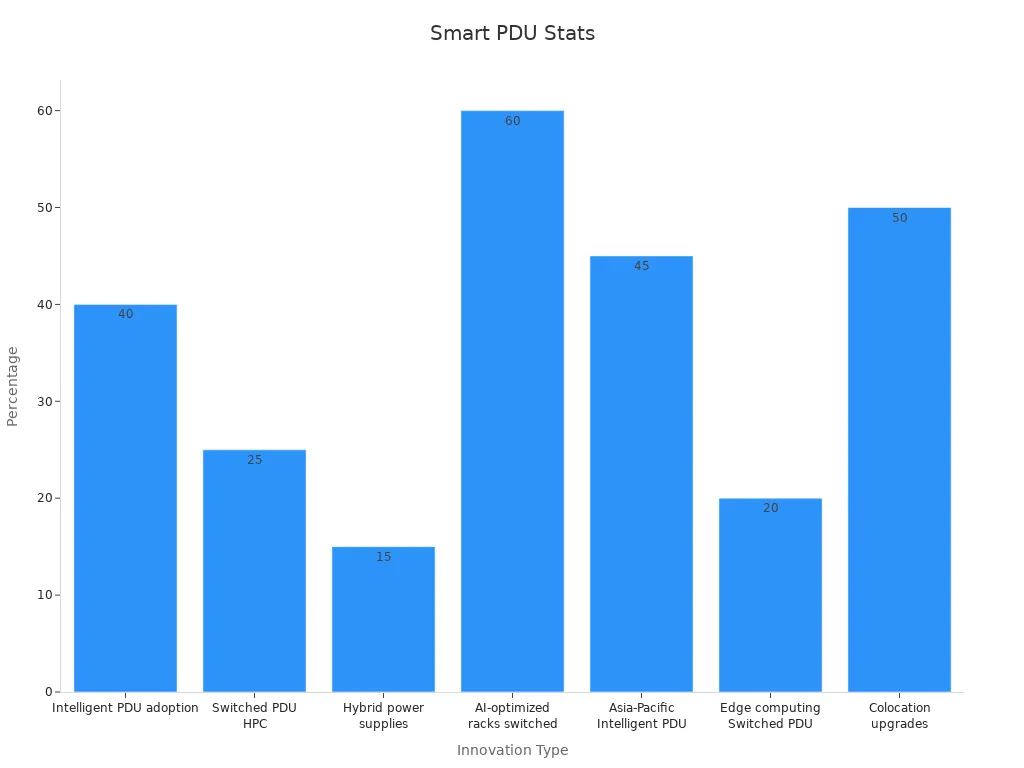
Predictions for the Next Decade
Industry forecasts show strong growth for intelligent power management. The global market for intelligent PDUs is expected to reach $8.7 billion by 2034, growing at a rate of 7.7% each year. The IT and telecom sectors will expand network server rooms by 10% annually, increasing demand for scalable power solutions. Intelligent PDUs could see 20% growth over the next five years. These devices help reduce operational costs by up to 30% and support sustainability by achieving Power Usage Effectiveness (PUE) as low as 1.2, compared to the industry average of 1.7.
| Forecast Aspect | Numerical Data / Trend Details |
|---|---|
| CAGR (2025-2031) | 8.8% CAGR for global data centre power distribution unit market |
| Intelligent PDU Growth | Highest growth expected within PDU types due to demand for advanced power management |
| Colocation Data Center Growth | Higher growth expected due to increasing cloud services and data storage needs |
| Regional Growth | North America expected to lead due to cloud service expansion |
| Energy Efficiency Focus | Shift towards energy-efficient PDUs to reduce costs and carbon footprint |
Smart PDU’s Role in Digital Transformation
Digital transformation relies on advanced infrastructure for real-time monitoring and control. Intelligent PDUs provide detailed analytics and remote management at the outlet level. These systems support metrics like availability, performance, and quality. Operators use unified dashboards to spot problems quickly and optimize equipment. Predictive maintenance becomes possible by tracking temperature, current, and power. Plants and data centers have reported double-digit productivity gains and cost savings after adopting these solutions. As technology advances, secure management of these systems will remain important to protect against cyber risks.
Smart PDUs form the backbone of intelligent power management. They deliver energy efficiency, reliability, and sustainability. The table below summarizes their impact:
| Aspect | Evidence Summary |
|---|---|
| Market Growth | Market valued at USD 3.47 Billion in 2024, projected to reach USD 5.4 Billion by 2032. |
| CAGR | 5.69% annual growth from 2026 to 2032. |
| Three-Phase PDUs | Support large data centers with higher capacity and efficiency. |
| Advanced Features | Real-time monitoring and remote management prevent downtime. |
| Operational Benefits | Optimize power use, reduce costs, and support scalability. |
Facilities that embrace innovation with smart PDUs will shape the future of power distribution.
FAQ
What is the main advantage of using a Smart PDU?
Smart PDUs provide real-time monitoring and remote control. They help facilities optimize energy use, reduce downtime, and improve operational efficiency.
Can Smart PDUs integrate with existing management systems?
Yes. Most Smart PDUs support integration with DCIM and other power management platforms. This feature allows centralized monitoring and streamlined operations.
How do Smart PDUs support sustainability goals?
Smart PDUs track energy consumption at each outlet. They help identify waste, support efficient resource use, and contribute to lower carbon footprints.
Post time: Jun-20-2025





